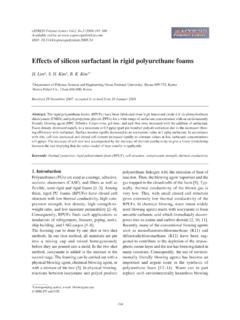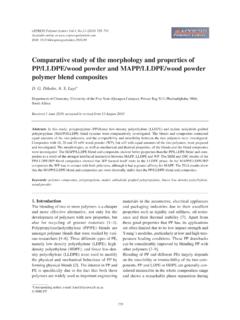Transcription of Ethylene-octene copolymer (POE) toughened …
1 EXPRESS Polymer Letters , (2009) 309 319. Available online at DOI: Ethylene-octene copolymer (POE) toughened polyamide 6/polypropylene nanocomposites: Effect of POE maleation M. U. Wahit1*, A. Hassan1, Z. A. Mohd Ishak2, T. Czig ny3. 1 Faculty of Chemical and Natural Resources Engineering, Universiti Teknologi Malaysia, 81310 Skudai, Johor, Malaysia 2 School of Materials and Mineral Resources Engineering, Universiti Sains Malaysia, Engineering Campus, 14300 Nibong Tebal, Penang, Malaysia 3 Department of Polymer Engineering, Faculty of Mechanical Engineering, Budapest University of Technology and Economics, H-1111 Budapest, M egyetem rkp. 3, Hungary Received 23 January 2009; accepted in revised form 15 March 2009. Abstract. Ethylene-octene elastomer (POE) and Ethylene-octene elastomer grafted maleic anhydride (POEgMAH) tough- ened nanocomposites of polyamide 6/polypropylene (PA6/PP) containing 4 wt% organophilic modified montmorillonite (MMT) were produced by melt compounding followed by injection moulding.
2 The PA6/PP composition was kept constant (PA6/PP = 70/30 parts) while the elastomer (either POE or POEgMAH) content varied between 5 and 20 wt%. PP grafted maleic anhydride (PPgMAH) was used to compatibilize the blend system. The impact strength of the nanocomposite sys- tem was examined by the conventional Izod impact test at room temperature (RT). In addition, linear elastic fracture mechanics (LEFM) approach was used to study the fracture response of the notched three point bending type specimens at room temperature (RT) and 40 C. Fracture surfaces of the broken specimens were examined using scanning electron microscopy. The results show that while POEgMAH can remarkably improve the compatibility between PA6 and the elas- tomer thus increasing the toughness, the unmodified POE has less significant contribution to PA6/PP/organoclay tough- ness.
3 Elastomer domains of POEgMAH show a finer and more uniform dispersion than that of POE in the PA6/PP/organoclay matrix. It is also observed that the toughness increased with the increasing elastomer concentration for both unmaleated and maleated POE. Keywords: nanocomposites, fracture toughness, impact strength, linear elastic fracture mechanics, Ethylene-octene elastomer 1. Introduction polymeric materials, binary or ternary blends Polymer-layered silicate nanocomposites have [2 6]. attracted increasing interest from both scientific However, for any single thermoplastics nanocom- and industrial perspectives because this new class posites system such as polyamide 6 (PA6) nano- of materials shows significant improvements in composites, incorporation of organoclay at high mechanical properties, barrier properties and ther- loading usually resulted in a severe embrittlement mal resistance at lower clay loading compared to manifested in a drop of the impact strength and pristine matrix [1].
4 In the last few years, much elongation at break [2, 7, 8]. For the thermoplastic effort has been devoted to develop the thermoplas- blend nanocomposites system, Chow et al. [3]. tic nanocomposites based on blends of two or more reported that PA6/PP nanocomposites exhibited *Corresponding author, e-mail: BME-PT. 309. Wahit et al. eXPRESS Polymer Letters , (2009) 309 319. improvement in modulus and strength as compared toughness of the nanocomposites but with limited to the pristine PA6/PP but at the expense of tough- success due to insufficient compatibility between ness. A similar observation has also been reported PA6 and POE. for micro-composites based on another blend sys- Conventionally, toughness has been characterized tem [5]. by the Izod impact test. However, the Izod impact The most widely applied method to overcome this test data cannot be used for design purposes, drawback is blending with elastomers such as although they can be used for comparing the tough- maleated ethylene -propylene copolymer (EPRgMAH) ness between different polymer systems.
5 With the [3, 7] and maleated styrene- ethylene -butadiene- objective to characterize toughness of polymer styrene rubber (SEBSgMAH) [9 11]. According to nanocomposites with greater accuracy, many Gonz lez et al. [11], the addition of up to 6% of an researchers have adopted fracture mechanics organoclay to a 70/30 PA6/SEBSgMAH blend led approach in their studies [2, 16, 17]. to ternary compounds combining the stiffness Furthermore, the toughness evaluation of PA6/PP/. improvement due to the inclusion of clay and the elastomer nanocomposites, particularly fracture toughening effect of the rubber. It was shown that toughness, has not been systematically investi- in the 70/30 blend with 3% organoclay, supertough gated. Only few studies can be found in the litera- behaviour of the nanocomposite was accomplished ture on the fracture behavior of PA6/PP/elastomer with a modulus increase of 44% with respect to the nanocomposites.
6 The results from our previous pure PA6 matrix. work have shown that for PA6/PP blend with the However, to our knowledge not many papers had 70/30 blend ratio, the toughness of the blends attempted to examine the fracture toughness of rub- increased significantly while the strength and stiff- ber toughened PA6/PP nanocomposites using lin- ness of PA6 was not much affected as compared to ear elastic fracture mechanics (LEFM) approach. other blend ratio 60/40 and 50/50 [7]. This is The objective of our study is to investigate the the reason why in this study varying amount of effectiveness of Ethylene-octene elastomer (POE) unmaleated and maleated POE have been incorpo- and Ethylene-octene elastomer grafted maleic anhy- rated to 70/30 PA6/PP nanocomposites. Particular dride (POEgMAH) as an impact modifier for attention will also be paid to the fracture toughness PA6/PP/organoclay blends system using conven- of the nanocomposites system measured using tional Izod impact test and LEFM approach.
7 POE, a LEFM. relatively novel polyolefin elastomer, was devel- oped by Dow Chemical Co. using a metallocene 2. Materials and sample preparation catalyst. Compared with EPR, POE typically exhibits easier mixing and better dispersion when The blends used in this work are described in blended with PP [7, 12 14]. In our previous work, Table 1. The PP (SM 240) was obtained from Titan POE was used as a toughening agent to form rub- PP Polymers, Johor Bahru, Malaysia. The melt ber- toughened PA6/PP nanocomposites [7, 14, 15]. flow index (MFI) and density were 25 g/10 min The result showed that the addition of POE to the and g/cm3 respectively. The PA6 (Amilan CM. PA6/PP (70/30) nanocomposites improved the 1017) was a commercial product of Toray Nylon Table 1. PA6/PP (70/30) nanocomposites blend composition [wt%].
8 PA6/PP Organoclay Designation Composition PPgMA POE POEgMAH. (70/30) TC. BC PA6/PP/PPgMAH 95 5. BC/F PA6/PP/ 91 5 4. BC/F/E5 PA6/PP/ 86 5 4 05. BC/F/E10 PA6/PP/ 81 5 4 10. BC/F/E15 PA6/PP/ 76 5 4 15. BC/F/E20 PA6/PP/ 71 5 4 20. BC/F/mE5 PA6/PP/ 86 5 4 05. BC/F/mE10 PA6/PP/ 81 5 4 10. BC/F/mE15 PA6/PP/ 76 5 4 15. BC/F/mE20 PA6/PP/ 71 5 4 20. 310. Wahit et al. eXPRESS Polymer Letters , (2009) 309 319. Resin AMILAN, Tokyo, Japan. The MFI at 230 C. and kg load and the density were 35 g/10 min and g/cm3, respectively. The maleated PP. (PPgMA) was Orevac CA 100 with ~ 1 wt% maleic anhydride (MA) produced by ATOFINA, Duteaux, France. The impact modifier, POE grade Engage 8150, was supplied by DuPont Dow Elastomers, Wilmington DE, USA. Its octene content and melt flow rate were 25 wt% and g/10 min, respec- tively.
9 ethylene octane elastomer grafted maleic anhydride (POEgMAH) Fusabond NMN 493 D. (medium MAH graft level) was a commercial prod- uct of Dupont, Wilmington DE, USA. Its melt flow index is g/10 min. The organoclay (Nanomer Figure 1. Characteristic force-time traces due to the ) was a commercial product of Nanocor impact of notched Charpy specimens Inc., Arlington Heights IL, USA. It was a white powder containing montmorillonite (MMT) room temperature (RT) and 40 C. The notch was (70 wt%) intercalated by octadecylamine (30 wt%). produced by saw and razor blade tapping. Impact- Following pre-designed composition ratios, PA6, ing of the specimens occurred under the following PP, PPgMAH, MMT and elastomer were dry conditions: mass of the striker: kg; striker blended in a tumble mixer, and then compounded working range: kN.
10 By the simultaneous addition of all components to a From the fractograms recorded as shown as an Berstoff co-rotating twin screw extruder. The barrel example in Figure 1, the maximum load (Fmax), and temperature was maintained at 200, 220, 230 and the energy absorbed up to Fmax (energy required for 240 C from hopper to die, and the screw rotation fracture initiation, Einit) were analyzed. For Kc speed was fixed at 50 rpm. Prior to blending, PA6 (based on Fmax) and Gc (based on Einit) determina- pellets were dehumidified using a dryer at 80 C for tion, the method adopted in ISO13586 was used 8 h. The extruded materials were injection moulded [18]. into standard tensile, flexural and Izod impact spec- imens using a JSW Model NIOOB II injection- 3. Results and discussion moulding machine with a barrel temperature of 210 240 C.




